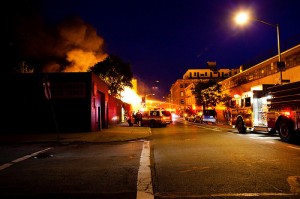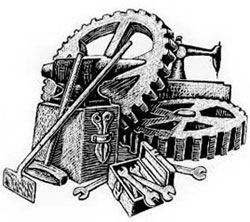
As I watched the evening sun go down last Saturday, July 4th, I had every reason to be optimistic about the holiday festivities to follow. It had been a beautiful day, the beer and burgers were plentiful, and, best of all, I had found a suitable perch on a friend of a friend’s rooftop deck in Greenpoint from which to watch the fireworks. Even though the location would have been far better in previous years, when the ‘works originated from a barge on the East River instead of on the Hudson, the considerable height of my rooftop vantage point gave me reason to believe I would get a good show even from the distant West Side.
But the show I got had some unexpected competition: minutes before the official display was to begin, a cloud of billowing black smoke, periodically illuminated by bright orange flames, appeared from an unknown source in nearby Williamsburg, by no means sufficiently distant to make my fellow revelers and I feel entirely at ease. Although the mysterious conflagration was more or less forgotten as the fireworks got underway, it nonetheless cast an ominous shadow on the events of the evening. I thought of a firefighter friend who I had visited just that morning at his South 2nd Street station, now surely battling the flames while we were drinking beer and taking in the spectacle of sound and light bursting just beyond the Manhattan skyline.
The miracle of RSS feeds and flickr pages revealed the origin of the mysterious fire before the end of the night. The victim of those impressive flames had been a veritable New York City institution, the Rosenwach Water Tank Company, which since at least 1896 has been building the distinctive wooden water tanks which dot the NYC skyline (the dates are somewhat subject to scrutiny due to the company’s fierce rivalry with its sole surviving competitor, Isseks Brothers – Rosenwach’s current president, Andy Rosenwach, traces his company’s beginnings to 1866). Due to extremely low water pressure stemming from its aged infrastructure and its situation on shallow bedrock, New York is the only city where these structures remain common – Rosenwach claims to build 200 to 300 a year. Since the 1860s, buildings in the city taller than six stories have used pumps to fill the tanks — fashioned from cedar planks and encircled with galvanized steel hoops – which then use gravity to send water to showers, sinks, and toilets.
While a next-day trip to the Rosenwach facility on North 9th and Berry Streets revealed a scene of devastation (not the least remnant of which was a charred BMW whose unfortunate owner had parked it just outside), no one was injured in the fire, and the company claims that the damage was not catastrophic to its business. Perhaps the more disturbing outcome of the fire is the swarm of commentary on blog postings blaming “hipsters†for the incident, often in language that doesn’t bear repeating on this blog. While it’s quite possible, even likely, that “white kids in their 20s shooting off Roman candles†started the blaze (despite the lack of evidence and the fact that, in my observation at least, folks of every ethnicity and background in every part of Brooklyn seem to enjoy taking part in the time-honored tradition of setting off illegal fireworks), the ugly tone of the commentary suggests that tensions in the now-gentrified neighborhood between longtime residents and newer, younger arrivals in North Brooklyn have reached an all-time high. While no one can defend some of the fratboy-esque behavior that any visit to Bedford Avenue on a weekend night will reveal, the scapegoating of “hipsters†(a largely meaningless, entirely media-invented term used as a catch-all for anyone of a certain age and affectation) seems to ignore the role played by other entities which might just as legitimately bear responsibility for the “hyper-gentrification†of Williamsburg – among them developers and the Bloomberg administration, which rezoned the neighborhood seemingly to specifications of the developers’ wildest speculative daydreams. The same administration, coincidentally, that in 2003 closed a neighborhood fire station, Engine 212, just blocks away from the fire took place. That, surely, is an irony at least as striking as that suggested by a fire at a company that builds water towers – and one that all residents of North Brooklyn could appreciate.
Last 5 posts by ASHP Staff
- FDR's Tree Army [now on Vimeo] - March 13th, 2013
- December Roundup - December 19th, 2012


